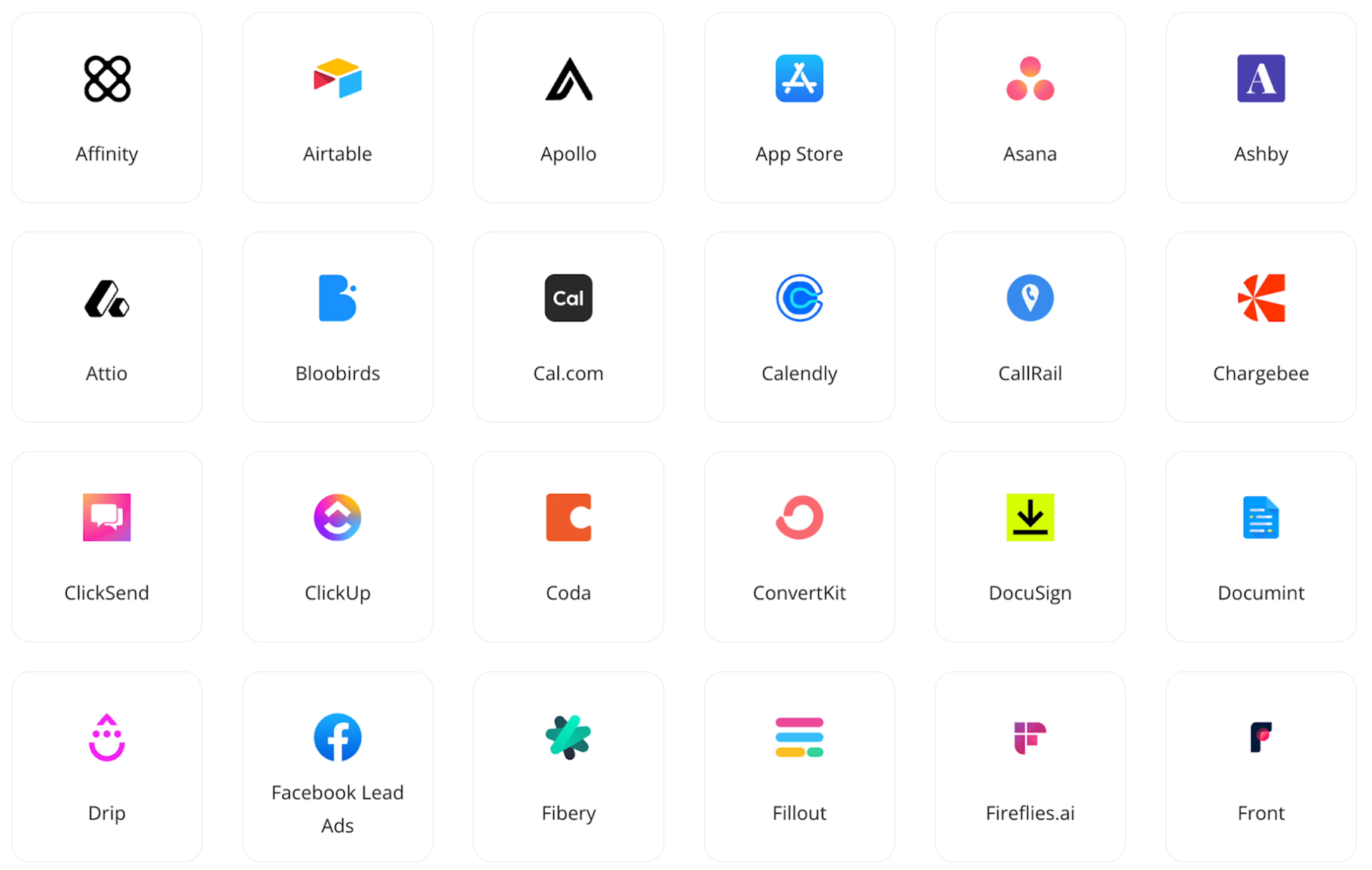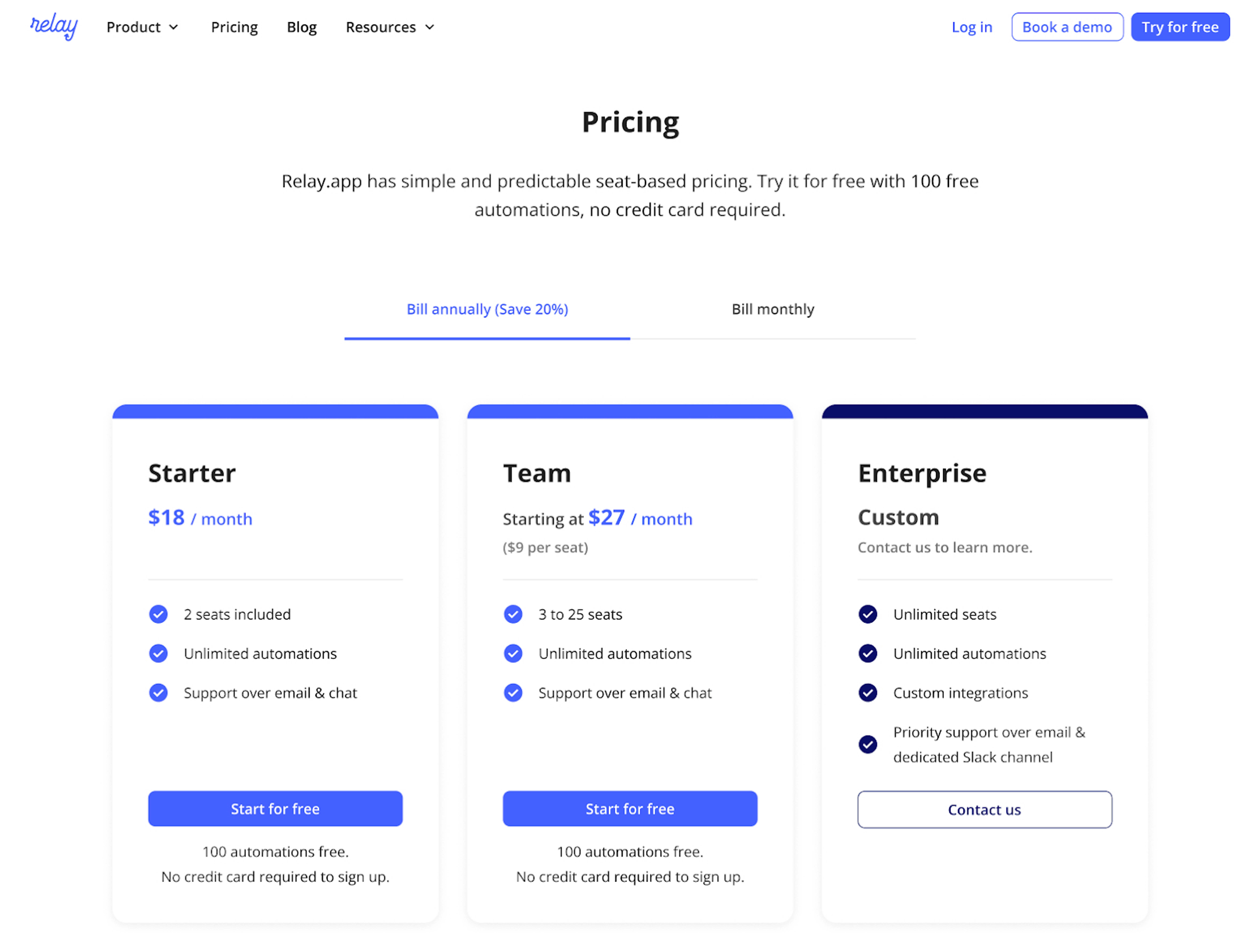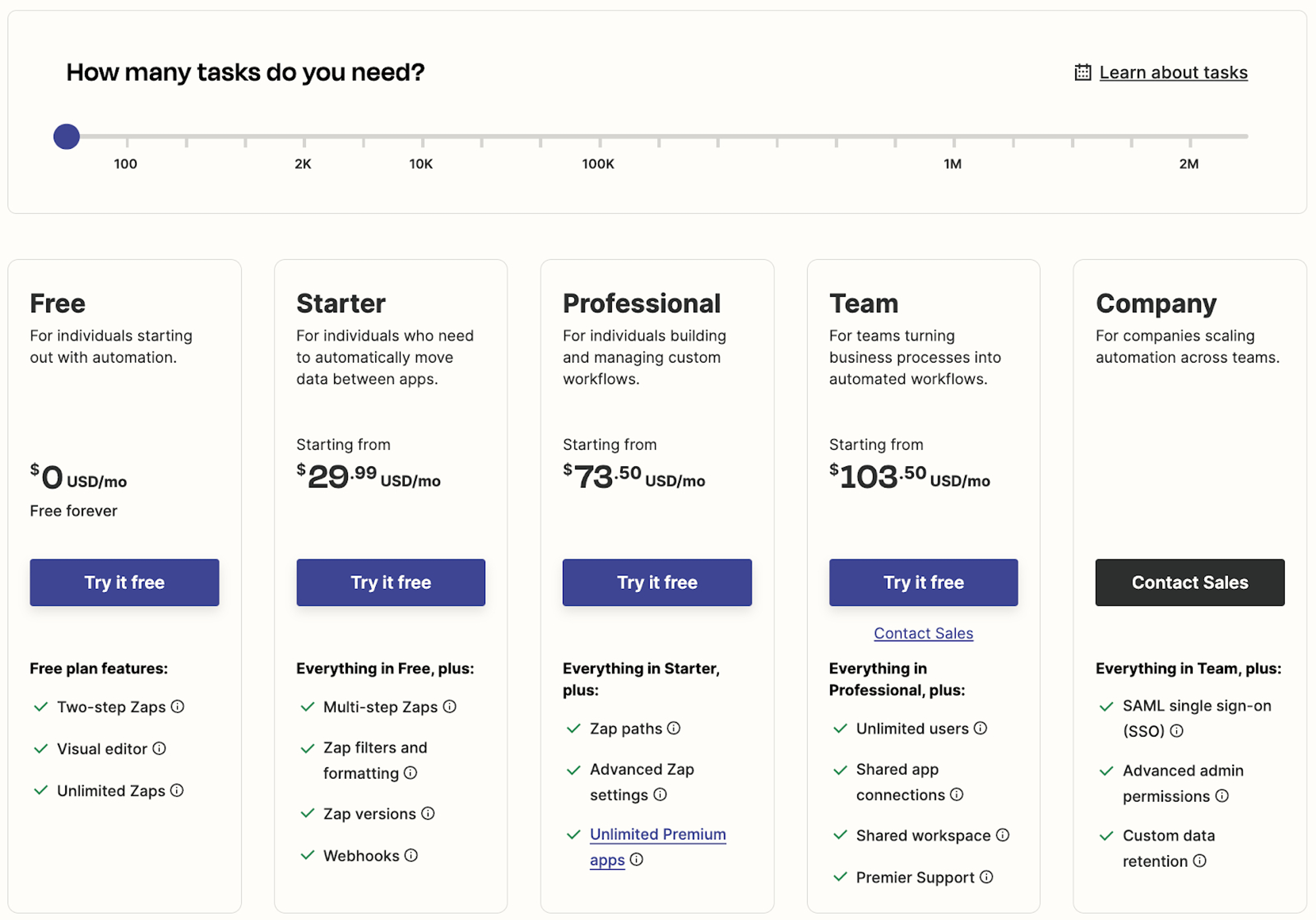
The Indian-based Pabbly Connect comes with 1,500+ integrations. It’s an affordable workflow automation builder with drag-and-drop capabilities for teams with simple processes.

As your company grows, however, Pabbly can be quite challenging. The company is still very young, and the product has bugs. Especially when it comes to troubleshooting.
If you need to get automations off the ground easily and without too much ongoing maintenance, we’d recommend looking for Pabbly Connect alternatives.
In this article, we talk about some of the popular ones like Relay.app, Butternut, Make, Zapier, and more.
Let’s dive in ⤵️
Why Would You Need Pabbly Connect Alternatives in the First Place?
There are two major reasons why you might need a Pabbly Connect alternative:
- Poor customer service paired with frequent product bugs.
- The platform will ask too much of your team.
Let’s discuss both these drawbacks in detail. ⤵️
#1 - Bugs + Poor Customer Service = Instability
Many G2 and Capterra reviewers have complained about Pabbly Connect’s customer service. The live chat feature on their website fails to resolve technical issues, and it takes time to connect with a human. Even if you do, chances are that you’ll have struggles.
Pabbly Connect’s knowledge base is also limited, with only a handful of YouTube videos.
Normally, customers can get over poor customer service if the product is flawless. It’s not the case here. Pabbly Connect still contains many bugs which limit the ability of teams to create automations by themselves and keep them stable over time.

#2 - Pabbly Connect is Challenging for Teams
Setting up complex workflows in Pabbly Connect is hard. It not only requires a basic understanding of APIs, webhooks, and data mapping but also comes with a clunky interface.
The tool is more complex to set up than other workflow automation platforms, and cannot allow team-based collaboration.
Learning how to correctly set everything Pabbly Connect will take some time. When workflows are not set up properly, they occasionally run multiple times instead of once, costing extra credits and creating troubleshooting bottlenecks.

What Are The Top Pabbly Connect Alternatives?
Some of the best alternatives to Pabbly Connect are:
- Relay.app – Keep humans in the workflow automation loop.
- Butternut – Easy-to-use, no-code workflow automation tool.
- Make – Modern integration platform as a service.
- DronaHQ – A low code automation tool.
- Qntrl – All-in-one workflow-building software.
- Airtable – AI-powered platform that enables teams to build custom apps and workflows.
- Tallyfy – Create and run automated, scalable workflows with AI.
- Zapier – Build workflow automation without relying on developers.
- Jira Automation – A powerful automation engine to build modern workflows.
1. Relay.app

Relay.app lets you automate actions and processes across apps. The software is better than most automation tools out there in the market because of its features such as human-in-the-loop, multiplayer, and 1-click automation AI.
Feature 1. Human In the Loop
Striking a perfect balance between fully automated workflows and delivering exceptional UI for internal teams and customers is tough. You often need a contextual touch without comprising efficiency.
Although providing the best experience to your customers, semi-automated flows can overload your team with tasks and notifications.
Relay.app’s solves this problem.
The Human in the loop feature lets you integrate human steps into automated workflows, in a way that is collaborative and efficient.
It offers the best of both worlds:
✅ Efficiencies and time savings of an automated process.
✅ The personalization and precision of human inputs.
The most popular Human in the Loop applications are:
- Approvals: In a deal-closing workflow, a manager’s approval is needed once a new contract is created. When approved, the workflow sends the customer a Docusign and waits for completion.
- Manual data inputs: In a customer onboarding workflow, the Account Executive (AE) for a closed deal is asked to provide a link to the deal’s summary notes, which will then be automatically shared with the Customer Success Manager (CSM).
- Human decisions: When a new support email arrives in a shared inbox, someone from your support team member is notified to classify it as either a complaint or a support request. Depending on the decision, either an email will be sent to the customer, or a support ticket will be created in Zendesk.
- Blocking manual tasks: In a sales workflow, after a deal is closed according to a CRM update, a task is assigned to the Sales Manager to create a contract draft. Once the contract is drafted by the manager, the workflow continues, and the document is shared with the other party's legal counsel for review.
Why is Human in the Loop Important?
There’s a misconception about humans involved in automations; that it slows down the process.
Indeed, the process may be a bit slower, but the effectiveness of the workflow goes up significantly.
Artificial intelligence, on the other hand, can’t replace human contextual awareness. Using AI without a human layer might accelerate workflows but reduce effectiveness and customer satisfaction.
These include processes such as:
- Personalizing semi-automated emails as part of customer onboarding/churn/feedback workflows.
- Human triage of incoming user feedback before automatically filing bugs in Jira/Linear.
- Manually assigning CSMs to a newly acquired customer.

Here’s a real example to help you understand the concept better 👇
Suppose you send churn emails to customers who opt out of your paid product.
Without humans involved, everyone will receive the same churn email with basic personalization.
Response rate? Likely very low…
With Relay.app, you can fire notifications as soon as the workflow starts, requesting that someone from the customer support team add context to the email.
Result? More feedback. Higher retention. And a tailored customer experience!
Feature 2. 1-Click AI Assistance
Your team likely doesn’t have time to prompt AI chatbots in the middle of workflows.
Unlike other workflow automation tools, Relay.app comes with purpose-built AI use cases that you can add to processes in one click.
For example, you can use AI Autofill to suggest paragraphs for emails and summarize content from a Notion page.
Or use AI Classify to intuitively guide your automation through conditional logic paths.
Feature 3. Collaborative Workflows
Most workflows are managed in silos. Relay.app promotes teamwork by letting you build playbooks alone or with your team.

💡 Looking to assign a support ticket to the right account owner in your CRM?
Relay.app can ingest data from your existing go-to-market tools, and create dynamic role assignments in workflows.
Relay.app Integrations
Relay.app currently integrates with applications like Calendly, ClickUp, Drip, Front, and many more (and constantly adding new ones).
Most importantly, apps are easy and seamless to deploy, with little to no oversight needed once published.

Pricing
With Relay.app’s free plan, you get 100 free runs and access to all features.
👀 Note: Unlike other automation tools on the market, all of Relay.app’s plans come with unlimited usage.
Need to onboard your team and increase the number of runs? Choose from three paid plans:
- Starter: $18 per month (for up to 2 users)
- Team: Starting at $27 per month ($9 per seat)
- Enterprise: Custom pricing

How Does Relay.app Compare to Pabbly Connect ?
Pabbly Connect creates constant dependencies, overloading your team with troubleshooting tasks and challenges, with little support from Pabbly’s support team.
Relay.app has a clear edge over by making it easy for anyone to collaboratively build automated and semi-automated workflows at scale.
With Relay.app, you can:
- Use AI to improve existing workflows.
- Get unlimited runs and predictable pricing.
- Add human steps as part of your workflows.
- Build workflows with your colleagues or other teams inside the company.
Pros and Cons
✅ Build for beginners with zero coding or workflow automation knowledge.
✅ Transparent and generous pricing tiers.
✅ Collaborative experience that scales with you.
❌ Fewer integrations than platforms like Zapier (we’re adding new integrations regularly).
2. Butternut

Butternut is an easy-to-use, no-code workflow automation tool.
It lets you integrate and automate workflows combining human actions and automated steps, giving you more control over processes.
Features
- Intuitive workflow builder, drag-and-drop apps, services, and flows.
- Offers programming control tools like conditional logic, data formatting, human-in-the-loop, and more.
- Connect pre-integrated apps like Airtable, Active Campaign, Gmail, and Slack, or use custom HTTP requests to communicate with any Rest API.
- Adjust or iterate workflows using versioning and environment deployment models.
Pricing
Butternut has a free forever plan that offers 1000 operations monthly.
Past 1000 operations, it offers simple usage-based pricing starting at $0.002 per operation.

Pros and Cons
✅ A beginner-friendly, drag-and-drop workflow builder.
✅ Pre-vetted integrations make it easy to connect apps.
❌ The pay-as-you-go pricing may turn out expensive for businesses looking to scale operations rapidly.
3. Make

Make is a modern Integration Platform as a Service (iPaaS) offering a simple visual workflow builder that makes it easy for anyone to create automations.
Features
- Has a playful drag-and-drop automation builder to easily integrate apps and create workflows. It doesn’t limit the number of steps and apps you add to scenarios.
- Gallery of 6,000+ pre-built automation templates to save time and build workflows in just a few clicks.
- The platform allows you to schedule workflows for future dates or when an event happens via triggers.
- Make’s no-code toolkit comes with handy tools to control every aspect of your workflow, from data formatting to execution without coding.
- Choose from a library of 1,600+ pre-built apps or connect using Make’s HTTP app.
- Offers advanced features like flow control, data manipulation, error handling, webhooks, etc.
Pricing
Make offers a free forever plan and three premium plans:
- Core: $10.59 per month
- Pro: $18.82 per month
- Teams: $34.12 per month
- Enterprise: Custom Pricing

Pros and Cons
✅ Make is beginner-friendly, with a small learning curve.
✅ Offers real-time collaboration with role-based permissions to manage team actions.
❌ The timeout limit for each run is 40 minutes. For bigger tasks, you might need multiple workflows.
4. DronaHQ

DronaHQ is a low-code automation tool that comes with a no-code workflow builder and a low-code stack.
This gives both non-coders and developers the freedom to automate custom processes.
Features
- Comes with a vast library of integrations to popular databases, third-party apps, and APIs.
- Build multi-step automation workflows using conditional blocks and logical steps, or add custom javascript to any step.
- Has 100+ ready-made action blocks to choose from and create interactive workflows.
- DronaHQ’s template library offers pre-built automation apps for different use cases.
- Get real-time alerts of specific events from data sources, APIs, or third-party apps, stay informed, and take action quickly.
Pricing
DronaHQ offers a 30-day free trial for its business plans. It categorizes plans into three pricing levels – User-based, Usage-based, and Developer only.
Let’s break down pricing plans for all levels.
- User-based plans:
- Starter: $12 per month
- Business: $28 per month
- Enterprise: Custom pricing
- Usage-based plans:
- Starter: $100 per month
- Business: $500 per month
- Enterprise: Custom pricing
You can get pricing for their Developer-only plan by contacting DronaHQ’s customer support.

Pros and Cons
✅ Workflows built using DroneHQ are highly configurable and customizable.
✅ The tool offers versatile pricing plans.
❌ You might encounter some bugs when using the tool, and you can’t expect much help from internal documentation and help guides due to their dull content.
5. Qntrl

Qntrl is an all-in-one workflow software. It lets you visualize, build, and manage workflows in one place.
Features
- Use custom cards, tables, and views to centralize and gain end-to-end visibility for all your workflows.
- The built-in form builder helps create forms with dynamic fields, making it easier to capture personalized and relevant data.
- An intuitive process builder that uses simple drag and drop to integrate apps.
- Define the flow of automation using conditional blocks, post-stage actions, custom rules, and more.
- Has a gallery of customizable workflow templates to quickly iterate, build, and scale automated workflows for different departments.
Pricing
Qntrl offers a 15-day free trial, after which you must purchase its business plan, which costs $8 per month.

Pros and Cons
✅ Has an intuitive dashboard that provides complete visibility over ongoing workflows.
❌ No free version is available.
6. Tallyfy

Tallyfy lets you create and run automated, scalable workflows with AI.
Features
- Uses AI to streamline process documentation, like creating processes in 10 seconds or auto-digitalizing uploads.
- Leave comments so your teammates can make changes in real-time.
- Measure views and ROI with Google Analytics.
Pricing
Tallyfy has no free plan. It comes, however, with a free trial for both paid plans:
- Tallyfy Docs: $5 per member per month
- Tallyfy Pro: $30 per member per month

Pros and Cons
✅ Generate AI templates in seconds.
✅ Add parallel and sequential steps in workflows.
✅ Sends automated reminders to your team.
❌ Can’t disable AI suggestions when creating workflows.
7. Zapier

Zapier lets you build workflow automation without relying on developers. Whether you need to automate a simple task or build an entire automated system, you can do it all on Zapier.
It’s the most used automation platform on the market and has the most native integrations.
Feature
- Connect, automate, and make 6,000+ apps work together without coding.
- Level up your Zaps with custom logic, conditions, and filters.
- Capture and nurture leads with custom forms and workflows.
- Tell Zapier AI what you want to achieve, and it’ll create a custom workflow template for you.
Pricing
Zapier comes with a free plan with basic features and five paid plans:
- Basic: Free forever
- Starter: $29.99 per month
- Professional: $73.50 per month
- Team: $103.50 per month
- Company: Custom pricing

👀 Note: If you start ramping up the number of Zaps used monthly, expect Zapier’s cost to increase significantly.
Pros and Cons
✅ Build workflows without relying on developers.
✅ AI-generated automations save a lot of time.
✅ Comes with a ton of ready-for-use templates and integrations.
❌ Zapier becomes increasingly expensive at scale.
8. Jira Automation

Jira offers a powerful automation engine that helps you and your team spend less time worrying about what-ifs and more time focusing on what’s next.
It seamlessly integrates with the Atlassian product suite but requires a paid subscription to unlock most capabilities.
Features
- Auto-assign work to your teammates and sync work across projects and products.
- Build automation rules in minutes; no code, no bottlenecks. All you need to do is select automation from their wide range of templates.
- Integrates with tools like Slack, Microsoft Teams, GitHub, Trello, and many more for enhanced collaboration.
Pricing
Jira offers a free plan with a limit of 10 users.
For more automations, storage, and AI, pick from three paid plans:
- Standard: $8.15 per user per month
- Premium: $16 per user per month
- Enterprise: Custom pricing

Pros and Cons
✅ Using, integrating, and managing Jira is easy.
✅ Lets you group tasks and create visual dashboards.
❌ Free plan is limiting.
❌ Hard to use if you aren’t on the Atlassian suite (Trello, Jira, Loom).
Build Powerful Automations with Relay.app
We’ve tested every single product listed above as Pabbly Connect alternatives. All are great solutions to create workflow automation without hassle.
But the burning question is: How do you determine which Pabbly Connect alternative is best for you?
The answer? Try some. Create workflows. And see which one fits your business best.
If you’re short on time and want to try the very best solution, sign up for Relay.app’s free trial and set up workflows (like this one) in minutes.

